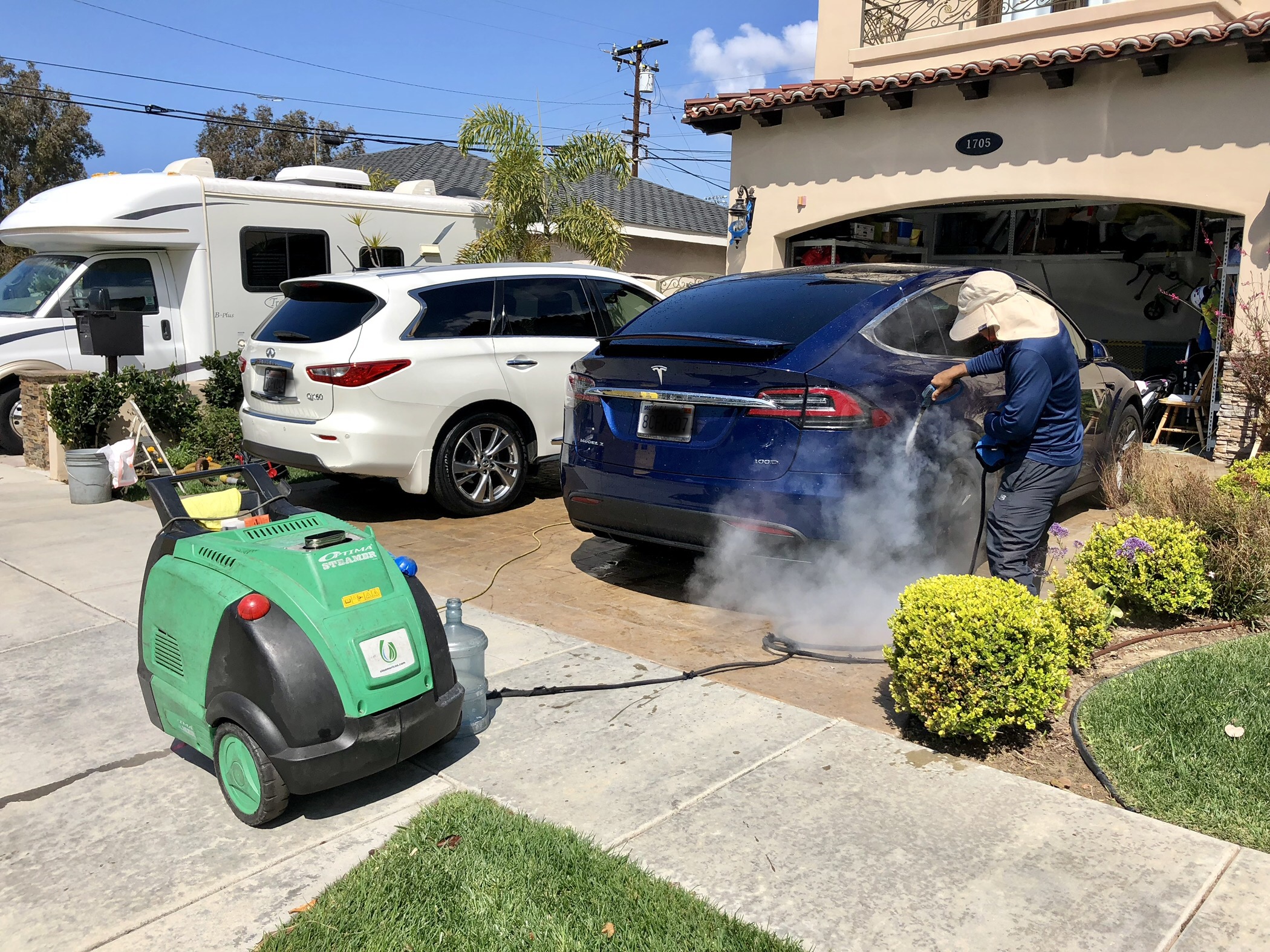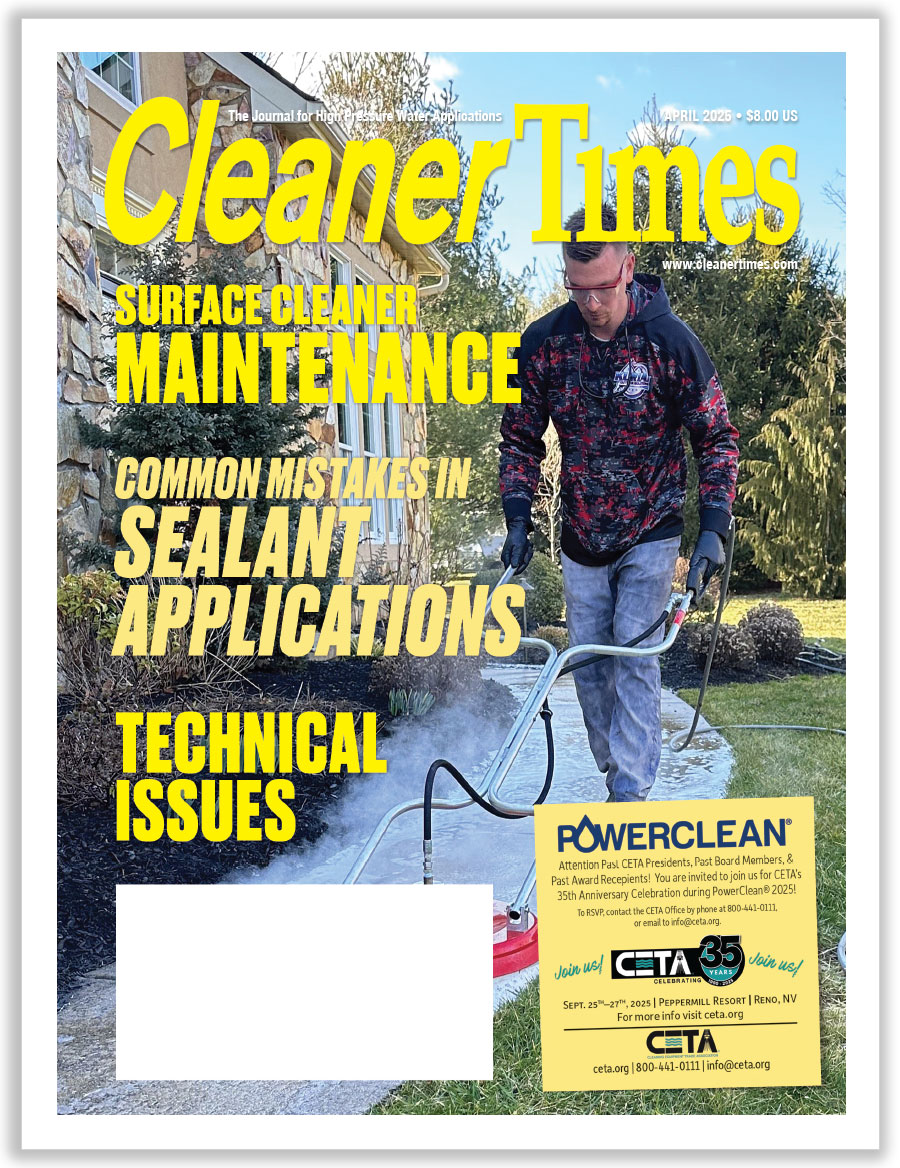
Cleaning Electric Vehicles
Written by Diane M. Calabrese | Published November 2024
Needless worry? If there’s worry at all… With the admonition not to mix water and electric current drilled into us from an early age, the prospect of washing an electric-powered vehicle might raise concerns. For instance, we would not think of dousing our electric stove with water when it is connected to the grid.
That’s where the essentials begin. There is “not really” a reason to be concerned about using water around electric vehicles says Robert Hinderliter, president of Steamaway Inc. in Fort Worth, TX.
“Just make sure to unplug them before washing,” says Hinderliter. Naturally, there are differences between electric and combustion-engine powered vehicles.
“There is not a need for motor degreasing, so there is less need for cleaning under the carriage and engine compartment,” explains Hinderliter. But that is only half the equation. Do electric vehicles stay cleaner than combustion-engine vehicles across similar intervals of use and road conditions? “On the exterior, no,” says Hinderliter. “But under the hood, yes.”
Hinderliter explains the difference in a nugget. “There are no petroleumbased emissions to collect on the electric vehicle,” explains Hinderliter. “Also, there are not leaks from the motor and transmission to splatter around on the frame and undercarriage, creating an attractant to the surface for road film to collect.”
Makers of electric vehicles [EVs] offer abundant information on the how-to of cleaning. And Yujin Yoo Anderson, general manager at Steamericas in Gardena, CA, says that anyone with specific questions should consult the user’s manual.
“For the most part water is okay for EVs,” says Anderson. “Care should still be taken to avoid directly spraying high-pressure water on sensitive areas like charging ports and exposed electrical components.”
Even at that the risk is minimal.
“The car’s design should protect sensitive areas, but avoiding prolonged exposure to water in these spots is a good precaution,” says Anderson.
For those accustomed to cleaning vehicles with combustion engines, the focus will change some with an EV as the target. “With EVs, extra attention should be paid to the areas around the charging ports and any visible electrical components,” says Anderson. “Since EVs have fewer moving parts and no engine bay to worry about, cleaning might be a bit simpler.”

Photo courtesy of Steamericas.
As to whether there is a difference in dirt accumulation that can be directly correlated with the power source for a vehicle, Anderson does not believe so. “It largely depends on the environment and condition it’s driven in,” she explains.
“However, since EVs lack tailpipes, they do not produce exhaust fumes that can contribute to soot and grime buildup on the rear of the vehicle, which might make them slightly cleaner in some cases,” says Anderson.
There are some trends that Anderson notices in EV cleaning. “I am aware that many of our car wash customers—adopters of the Optima Steamer—have a disproportionately large number of EV owners.”
Moreover, Anderson suggests the alignment between EV and steam cleaning is a natural one. “I believe that it is because steam cleaning aligns with the eco-friendly nature of electric vehicles.”
Steam cleaning conserves water and energy. “It reduces water usage by up to 95 percent compared to pressure washing, hence little to no runoff, and typically requires fewer or no chemicals, making it an environmentally responsible method,” explains Anderson.
The commitment that EV owners have to the environment may extend to their willingness to pay a premium to conduct activities in a way that helps protect it. “[Many] EV owners are willing to pay a premium for sustainable methods,” says Anderson.
The Golden State leads the nation in its push to develop rules that improve air and water quality. Compliance often gets a boost from new technologies such as EVs and steam cleaning, as well as the juncture at which the two meet.
“Steam cleaning helps companies to be in compliance with CARB’s SORE restrictions, AQMD rule 222 in California, and the federal Clean Water Act,” says Anderson. [CARB is the California Air Resources Board, SORE refers to a small off-road engine, AQMD is the Air Quality Management District. The South Coast AQMD, for instance, requires regular filing of emissions data from businesses anchored within its region—a wide swath of Southern California around Los Angeles.]
Some readers may be looking at the rules list Anderson shares and thinking most do not apply. That is a short-sighted perspective given that states across the nation are modeling their rules after those in California.
Adaptation
We are in a period of transition. (True, we could say the same about any point in time. But the rapidity of change makes it remarkable.) Consequently, new tools and techniques for using and maintaining them are developing sometimes in parallel and sometimes not.
How to best clean EVs brings many inquiries. “While this may seem pretty basic, this topic comes up daily in our showroom,” says Josh Wagner, retail manager at Atlantic Pressure Washers in Linthicum Heights, MD.
“How-to is also becoming a more common inquiry on professional forums,” says Wagner. He adds that given the investment a car owner makes in an EV, it’s understandable there is keen interest in protecting the investment.
Wagner’s company provides website content to help customers. Available content includes instructional videos.
For instance, Kränzle USA offers a K1622TS pressure washer and foam combo, which can be used on the exterior of an EV. “We’ve made an instructional video covering prework needed to wash a Tesla, as well as the safest way to wash it,” says Wagner, adding the video serves both owner operators and entrylevel auto detailers.
“Our goal in making that content was to support vendors who receive inquiries,” explains Wagner. “As EV technology evolves, so will the processes associated in caring for EVs. Five years from now we will likely have a whole different take on this same topic.”
But back to where we are in 2024. “Extra care should be taken when washing an EV,” says Wagner. “This point is driven home by the use of many manufacturers installing programs such as ‘car wash mode’ or ‘water mode’ into the EV’s console.”
Wagner explains each manufacturer’s approach is different. But a console selection for car wash mode will typically disable automatic wipers, neutral lock out, and automatic mirrors and door handles. “In some cases it actually creates a temporary vacuum sealing out critical areas that could be exposed—like the charge port.”
If an EV has a car wash mode, Wagner recommends taking advantage of it. “Beyond that, it’s simply a matter of taking care of the vehicle’s critical areas—not flooding cameras and taking extra care around the trunk or extra compartments.”
Wagner suggests that reflection on the difference between EVs and internal combustion engine (ICE) vehicles gives an owner, car wash operator, or detailer a better feeling for where the differences may be important in cleaning. And it reinforces the importance of taking care with high pressure.
“Technically everything is watertight or water resistant from the manufacturer of an EV,” explains Wagner. “But the manufacturer is accounting for naturally occurring water such as puddles, heavy rainstorms, and brief floods of water as other vehicles splash puddles around it.”
The greatest risk is posed by an autonomous operation or an untrained operator that forces water at an “unnatural angle” into an area that’s “not intended to get wet or saturated,” says Wagner. ICE vehicles are more tolerant of the pressure and the water.
What makes the ICE vehicle more tolerant of errant water? “Due to the way ICE vehicles produce excess heat, even at idle, any fluid resting somewhere critical is quick to evaporate,” explains Wagner. “On an EV, you have heat generation but it’s nowhere close to an ICE.”
In addition, electrical components that are water sensitive can short out if they get soaked. There’s not enough heat around those components to dry them out quickly as would happen in an ICE vehicle.
If an EV requires less frequent cleaning, its owner can pay more to ensure that the vehicle gets attention from an exacting and well-matched method— steam, foam plus water, etc.—when it does get a routine cleaning. Still, the are-EVs-cleaner (than ICE vehicles) question lingers.
Does the EV stay cleaner across equivalent intervals? “From our perspective, EVs are cleaner than ICE vehicles,” says Wagner. To illustrate he gives us a comparison between two similarly sized pickup trucks, a Rivian RIT and a Ford Ranger.
Exhaust, road contaminants, and brake dust contribute to soiling. “The EV cuts down drastically on two of these,” says Wagner.
Wagner says he understands the believe-it-or-not take some of us may have when we think about the difference. “Both vehicles are exposed to the same road conditions, but the EV naturally has less pollution than the Ranger, plus minimum brake dust.”
The explanation? “Due to the regenerative braking on the EV, the dust that is present on the Ranger will be drastically heavier than the Rivian,” explains Wagner. “This in turn means the wheel area on the Rivian looks cleaner longer.”
But EVs do not stay clean forever— just a bit longer, perhaps






